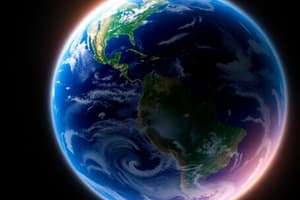Podcast
Questions and Answers
What is the primary function of the ozone layer in the atmosphere?
What is the primary function of the ozone layer in the atmosphere?
- It provides oxygen for breathing.
- It filters out all forms of radiation.
- It absorbs high energy UV light and converts it into heat. (correct)
- It regulates the temperature of the Earth.
Which layer of the atmosphere is the coldest, with temperatures reaching around -100°C?
Which layer of the atmosphere is the coldest, with temperatures reaching around -100°C?
- Stratosphere
- Troposphere
- Mesosphere (correct)
- Thermosphere
In which layer of the atmosphere do most meteors burn up?
In which layer of the atmosphere do most meteors burn up?
- Mesosphere (correct)
- Thermosphere
- Stratosphere
- Troposphere
What happens to temperatures as one ascends through the troposphere?
What happens to temperatures as one ascends through the troposphere?
What is the significance of the Greenhouse Effect in relation to Earth's atmosphere?
What is the significance of the Greenhouse Effect in relation to Earth's atmosphere?
What effect does humidity have on daily maximum temperatures?
What effect does humidity have on daily maximum temperatures?
How does cloudiness affect the diurnal temperature range?
How does cloudiness affect the diurnal temperature range?
What role does wind speed play in temperature variation?
What role does wind speed play in temperature variation?
What is identified as the primary mode of interaction in the text?
What is identified as the primary mode of interaction in the text?
How does albedo influence diurnal temperature range?
How does albedo influence diurnal temperature range?
What causes water movement according to the given content?
What causes water movement according to the given content?
What phenomenon occurs as a result of elevation differences between valleys and mountains?
What phenomenon occurs as a result of elevation differences between valleys and mountains?
Which phenomenon is mentioned as a tropical mode of interaction?
Which phenomenon is mentioned as a tropical mode of interaction?
What is the source of energy that is gained in the water movement described?
What is the source of energy that is gained in the water movement described?
What area does the document pertain to?
What area does the document pertain to?
Which of the following is not mentioned as a process related to energy gain in water movement?
Which of the following is not mentioned as a process related to energy gain in water movement?
Which institution is associated with the information provided?
Which institution is associated with the information provided?
What measurement unit is mentioned in the context of transport?
What measurement unit is mentioned in the context of transport?
What primarily heats the troposphere?
What primarily heats the troposphere?
How does the tropopause height in the tropics compare to the poles?
How does the tropopause height in the tropics compare to the poles?
What temperature range is observed in the tropics near equatorial regions?
What temperature range is observed in the tropics near equatorial regions?
Which region is known for having the highest range of annual temperatures among tropical continental regions?
Which region is known for having the highest range of annual temperatures among tropical continental regions?
What factor contributes to the vertical expansion of the troposphere in the tropics?
What factor contributes to the vertical expansion of the troposphere in the tropics?
What effect does deep tropical clouds have on energy transfer in the atmosphere?
What effect does deep tropical clouds have on energy transfer in the atmosphere?
Which area experiences the highest range of temperatures among midcontinental regions?
Which area experiences the highest range of temperatures among midcontinental regions?
What is the average height of the tropical tropopause?
What is the average height of the tropical tropopause?
What process releases latent heat to the atmosphere?
What process releases latent heat to the atmosphere?
Which of the following is a source of moisture for convection in tropical regions?
Which of the following is a source of moisture for convection in tropical regions?
What primarily shapes the strength and location of convection in the atmosphere?
What primarily shapes the strength and location of convection in the atmosphere?
What is typically indicated by low Outgoing Longwave Radiation (OLR) regions?
What is typically indicated by low Outgoing Longwave Radiation (OLR) regions?
Which factor is NOT a part of surface-atmosphere interactions concerning energy transport?
Which factor is NOT a part of surface-atmosphere interactions concerning energy transport?
What is the primary consequence of spatial and temporal changes in convective areas?
What is the primary consequence of spatial and temporal changes in convective areas?
During which process is latent heat removed from the atmosphere?
During which process is latent heat removed from the atmosphere?
Which region is associated with the lowest Outgoing Longwave Radiation based on the provided information?
Which region is associated with the lowest Outgoing Longwave Radiation based on the provided information?
Which of the following best describes the role of tropical oceans in convective processes?
Which of the following best describes the role of tropical oceans in convective processes?
Which process is integral to the transport of energy within and from the tropics?
Which process is integral to the transport of energy within and from the tropics?
Flashcards are hidden until you start studying
Study Notes
Layers of the Atmosphere
- The atmosphere has a thickness comparable to an onion's skin, crucial for life on Earth.
- Protects from harmful solar radiation and maintains warmth via the Greenhouse Effect.
- Divided into four main layers based on temperature:
- Troposphere: Contains most of the atmosphere's water and where weather occurs; temperature decreases with altitude.
- Stratosphere: Contains the ozone layer which absorbs UV light, increasing temperatures with altitude.
- Mesosphere: Coldest layer, reaching -100°C; most meteors burn up here.
- Thermosphere: Temperatures can exceed 2000°C, but air is too thin to breathe.
Latitudinal Distribution of Incoming Radiation
- Maximum solar radiation is observed at the equator and minimum at the poles.
- Radiation spreads over greater areas at higher latitudes due to beam depletion by the atmosphere.
Latent Heating and Convective Cloud Distribution
- Latent heat transfer is essential for energy transport and atmospheric circulation.
- Condensation and precipitation release latent heat, while evaporation removes it.
- Tropical oceans are key moisture sources for convection, influenced by surface heat fluxes.
Mean Outgoing Longwave Radiation (OLR)
- OLR from 1979 to 1995 indicates patterns of energy emitted by deep convective clouds.
- Areas with blue and red show the lowest OLR.
Annual Cycle of Cloud Tops
- Significant spatial and temporal changes in convective areas affect global climate dynamics.
Surface-Atmosphere Interactions
- Integral for energy transport within the tropics.
- Evaporation driven by wind momentum enhances water movement and energy exchange.
Atmospheric Structure and Heating
- Troposphere is primarily heated from below via latent heat and longwave radiation.
- Tropical regions experience a vertical expansion, with the tropopause at 18 km, higher than at the poles (averaging 11 km).
Seasonal and Geographic Temperature Distribution
- Tropics maintain a low temperature range (<1.5°C), with more significant variances found in midcontinental areas.
- Australia exhibits the highest temperature range (21-32°C) among tropical continental regions.
Diurnal Temperature Variability
- Factors affecting mean diurnal temperature range:
- Humidity moderates temperature variation; higher moisture leads to cooler daytime high temperatures.
- Cloudiness cools days and warms nights, reducing the diurnal range.
- Wind speed enhances mixing of air, moderating temperature extremes.
- Albedo: High reflectivity surfaces remain cooler than low reflectivity ones.
- Elevation impacts heating, causing distinct temperature patterns between mountain and valley areas.
Extreme Temperatures in the Tropics
- Tropical regions can experience extreme temperature variations due to local environmental factors.
Studying That Suits You
Use AI to generate personalized quizzes and flashcards to suit your learning preferences.




